Merrily We Roll Along 2022: Difference between revisions
No edit summary |
|||
| (4 intermediate revisions by the same user not shown) | |||
| Line 60: | Line 60: | ||
=='''Overview'''== | =='''Overview'''== | ||
Merrily We Roll Along is a 1981 American musical with music and lyrics by Stephen Sondheim and a book by George Furth. It is based on the 1934 play of the same name by George S. Kaufman and Moss Hart. | |||
Merrily premiered on Broadway on November 16, 1981, in a production directed by frequent Sondheim collaborator Hal Prince, with a cast almost exclusively of teenagers and young adults. The show was not the success the previous Sondheim–Prince collaborations had been: after a chaotic series of preview performances, it opened to widely negative reviews, and closed after 16 performances and 52 previews. | |||
=Technical Stage Department= | =Technical Stage Department= | ||
| Line 85: | Line 86: | ||
To keep it simple we labelled the positions of set 1, 2 and 3 based on the order in the show. 1 being its first appearance. | To keep it simple we labelled the positions of set 1, 2 and 3 based on the order in the show. 1 being its first appearance. | ||
The Truss truck had two sets of track, one US and one DS. The Upstage track had two gauzes from stock tied together that would be pulled on stage and off stage by the cast as part of the scene changes. The DS Track Had a | The Truss truck had two sets of track, one US and one DS. The Upstage track had two gauzes from stock tied together that would be pulled on stage and off stage by the cast as part of the scene changes. The DS Track Had a ''Decorative Screen'' made out of steel which was heavy, that had to be set by TSD during the interval. | ||
| Line 99: | Line 100: | ||
===Truss Truck (Kinesys)=== | ===Truss Truck (Kinesys)=== | ||
The process to moving the trucks for this show was definitely a journey in itself. Knowing the limitations of crew situation, and how heavy the trucks were going to be, it became clear that automating them was the way forward. | The process to moving the trucks for this show was definitely a journey in itself. Knowing the limitations of crew situation, and how heavy the trucks were going to be, it became clear that automating them was the way forward. | ||
Using 2 Kinesys Motors, Knowing we had our old 3d Automation pulleys, [[Toby Cass]] and I worked out Angle Factor to ensure we could pull the 1 Ton Truck both ON Stage and all the way OFF stage. One of the main challenges was wing space. The truck had to travel 5 meters to be hidden behind the masking flats. This eventually caused us pulling the line all the way to the last 2mm of the Low Return Pulley. | |||
===DS Truck(Kinesys)=== | ===DS Truck(Kinesys)=== | ||
DS Truck | DS Truck | ||
The original idea for the DS truck movement was to use a Truck Winch (https://shop.flints.co.uk/Product-Details/All/FHS510T?proddesc=Truck-Winch-with-fitted-Trip-Meter&category=pg_truckwinches&catdesc=Truck-Winches) | The original idea for the DS truck movement was to use a Truck Winch (https://shop.flints.co.uk/Product-Details/All/FHS510T?proddesc=Truck-Winch-with-fitted-Trip-Meter&category=pg_truckwinches&catdesc=Truck-Winches) | ||
This spun onto the idea of reaving one of our Big Tow automation lines back onto the winch, Allowing for US and DS movement from the one winch. The only issue with this idea is that our drops and diverts for the grid automation beams are designed to take only 1 line. We’d have had to have another one bespoke made. | This spun onto the idea of reaving one of our Big Tow automation lines back onto the winch, Allowing for US and DS movement from the one winch. The only issue with this idea is that our drops and diverts for the grid automation beams are designed to take only 1 line. We’d have had to have another one bespoke made. | ||
Due to the set being sustainably made out of steel deck, it became very heavy quickly. The DS Truck estimated at roughly 600Kg minimum. | |||
=Lighting= | =Lighting= | ||
=Stage Management= | |||
=Sound= | =Sound= | ||
Latest revision as of 14:08, 14 March 2023
Overview
Merrily We Roll Along is a 1981 American musical with music and lyrics by Stephen Sondheim and a book by George Furth. It is based on the 1934 play of the same name by George S. Kaufman and Moss Hart.
Merrily premiered on Broadway on November 16, 1981, in a production directed by frequent Sondheim collaborator Hal Prince, with a cast almost exclusively of teenagers and young adults. The show was not the success the previous Sondheim–Prince collaborations had been: after a chaotic series of preview performances, it opened to widely negative reviews, and closed after 16 performances and 52 previews.
Technical Stage Department
Design
At the White card stage, Merrily We Roll Along presented a huge challenge with multiple flying pieces and many moving set pieces. The biggest worry initially was that the Technical Stage Department was made up of the Head of Stage, a Deputy, and one Head of Flys. This posed a huge question as to how we could pull off the multiple scene changes. The set stayed very true to how it was at the white card. One major change was needed, however. To support the moving ‘Gallery’ Set piece which was 3m tall and 1.2m wide it posed the threat of being unstable, wobbly and tippy. The workshop manager decided that a ‘Truss Goalpost’ was needed on either side of the truck to support the steel-framed flat and stairs around the truck. This involved moving all of the Upstage set pieces 400mm further upstage.
Light Ladders
Two 1400mm x 6100mm Flats were built with Steel 'Ladder' like extensions and festoon. These were to feature in 3 different positions throughout the different scenes.
The lx cable was cable tied to bobbins to allow it to move freely with the set pieces.
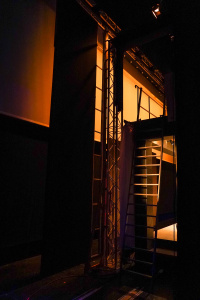
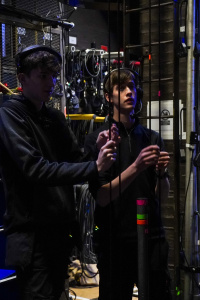
Truss Truck (Gallery)
The truss truck was built our of two wooden bases on Tri - Castors, with 4 truss baseplates and 4 corners. It had 3 Positions during the show. ON, Half way off, and OFF. To keep it simple we labelled the positions of set 1, 2 and 3 based on the order in the show. 1 being its first appearance.
The Truss truck had two sets of track, one US and one DS. The Upstage track had two gauzes from stock tied together that would be pulled on stage and off stage by the cast as part of the scene changes. The DS Track Had a Decorative Screen made out of steel which was heavy, that had to be set by TSD during the interval.
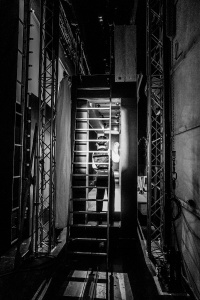
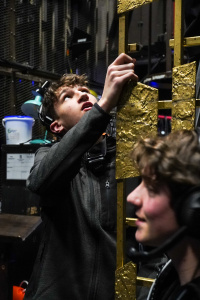
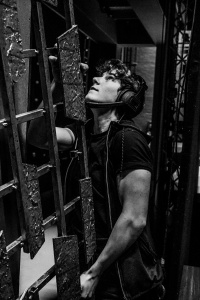
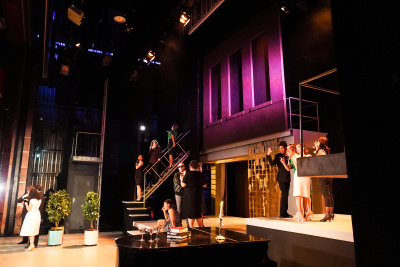
Truss Truck (Kinesys)
The process to moving the trucks for this show was definitely a journey in itself. Knowing the limitations of crew situation, and how heavy the trucks were going to be, it became clear that automating them was the way forward.
Using 2 Kinesys Motors, Knowing we had our old 3d Automation pulleys, Toby Cass and I worked out Angle Factor to ensure we could pull the 1 Ton Truck both ON Stage and all the way OFF stage. One of the main challenges was wing space. The truck had to travel 5 meters to be hidden behind the masking flats. This eventually caused us pulling the line all the way to the last 2mm of the Low Return Pulley.
DS Truck(Kinesys)
DS Truck The original idea for the DS truck movement was to use a Truck Winch (https://shop.flints.co.uk/Product-Details/All/FHS510T?proddesc=Truck-Winch-with-fitted-Trip-Meter&category=pg_truckwinches&catdesc=Truck-Winches) This spun onto the idea of reaving one of our Big Tow automation lines back onto the winch, Allowing for US and DS movement from the one winch. The only issue with this idea is that our drops and diverts for the grid automation beams are designed to take only 1 line. We’d have had to have another one bespoke made.
Due to the set being sustainably made out of steel deck, it became very heavy quickly. The DS Truck estimated at roughly 600Kg minimum.
Lighting
Stage Management
Sound
One of the main challenges of this show was the pit being at half-height. This of course meant less control in the front of house mix, and an overall louder sound in the auditorium before amplification. This also meant carefully runnning our cables up onto the pit lift, including cue and comms cables as well as cat5 for personal monitoring. It was important that this was made safe for the muscicians by making cable runs as clean as possible.
This also meant rigging the MD Camera with a hex-clamp and camera rigging to the underside of the stage to ensure a good view of the MD.
Video
This show used two projectors, one in the FOH truss position and the other on stage on LX 1. This was due to the two different projection surfaces, one being the gauze and the other a flown balcony piece. Two projectors were used to adhere to the focal lengths.
Notes: Kramer HDMI to CAT5 extenders won't draw enough power when an optical HDMI is used on the other end of it.
Additionally, an old CRT monitor was to be used on stage, with a live camera feed going to it through the disguise server. However, due to the digital-to-analogue converter breaking, the monitor was sadly cut.
Here you can see the system diagram of the set-up. File:MWRA - Systems Diagram V002.pdf
